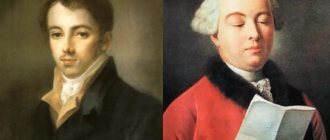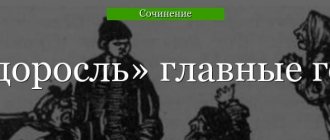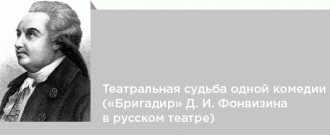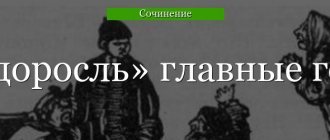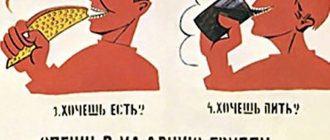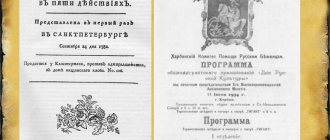April 14, 1745 – December 12, 1792 (47 years old)
4.3
Average rating: 4.3
Total ratings received: 2589.
Fonvizin Denis Ivanovich (1745–1792) - Russian writer, playwright, publicist, translator, representative of Russian classicism, creator of national everyday comedy. Author of the famous play "The Minor". Fonvizin was called the “father of Russian comedy”: the public received his theatrical plays with delight.
The material was prepared jointly with a teacher of the highest category, Kuchmina Nadezhda Vladimirovna.
Experience as a teacher of Russian language and literature - 27 years.
Childhood and education
Denis Ivanovich Fonvizin was born on April 3 (14), 1745 in Moscow into a noble family descended from a Livonian knightly family. The future writer received his primary education at home. A patriarchal atmosphere reigned in the Fonvizin family.
Since 1755, Denis Ivanovich studied at the noble gymnasium at the university in Moscow, then at the Faculty of Philosophy of Moscow University. In 1760, Fonvizin, among the “selected students,” left for St. Petersburg, where he met Lomonosov and Sumarokov.
The beginning of a creative journey
Since the 1760s, Denis Ivanovich created his first works. Fonvizin's early work was distinguished by its sharp satirical orientation. Thus, presumably, a play that was not published during the author’s lifetime, the so-called “early “Minor,””, first published only in volumes 9-10 of the “Literary Heritage” series in 1933, dates back to the 1760s. At the same time, the writer was engaged in translations. In 1761, Fonvizin translated Holberg's fables into Russian. In 1762 - works by Terrason, Voltaire, Ovid, Gresse, Rousseau.
Since 1762, Fonvizin has worked as a translator, and since 1763 - secretary of the cabinet minister Elagin in the Collegium of Foreign Affairs. In 1769, Denis Ivanovich entered the service of Count Panin as his personal secretary.
In 1768, the writer created the satirical comedy “The Brigadier”. The play received a wide response, and Fonvizin, whose biography was still unknown in high circles, was invited to Peterhof to read the work to Empress Catherine II herself.
FONVIZIN
FONVIZIN Denis Ivanovich [3(14).4.1743 or 1745, Moscow – 1(12).12.1792, St. Petersburg], Russian. writer, playwright, translator; member Ross. academy (1783). From a German noble family. origin (the surname was spelled von Wisin until the mid-19th century). In 1755–60 he studied at the Moscow gymnasium. University, in 1761–62 – in philosophy. f-those of the same university, then began lit. activities: translated “Moral Fables” by L. Holberg (1761; 2nd ed., 1765), Voltaire’s tragedy “Alzira, or the Americans” (1761 or 1762, published in 1888), etc.; several small translations of F. appeared in the university magazines “Useful Amusement” (1761–62) and “Collected Best Works” (1762).
In the 2nd half. 1762 entered service in the College of Foreign Affairs. affairs, with diplomatic went to Germany on an errand. In the summer of 1763 he moved to St. Petersburg, became secretary of the cabinet minister I.P. Elagin, entered his literary and theatrical circle, where, competing with V.I. Lukin, he began remaking foreign works. plays (“inclination” of them “to our morals”): poetry. comedy “Corion” (posted in 1764, published in 1835) based on the play “Sydney” by J. B. L. Gresse. In 1769, in an appendix to one of the translations, he published a poem that became very popular. satire “Message to my servants Shumilov, Vanka and Petrushka.” Of F.'s translations, the greatest success was the translation of the prose poem by P. J. Bitobe on the biblical story “Joseph” (1769). In Oct. 1768 – Apr. 1769, while on vacation in Moscow, he wrote the comedy “The Brigadier” (posted in 1772, published in 1786), which was the first Russian comedy. original "comedy of manners". The characters' behavior and speech patterns are presented as conditioned by their life experiences and societies. position, and, although the whole action of the comedy is comic. love explanations with the subsequent exposure of unfaithful husbands, as a result a socially and historically defined picture of morals emerges. In particular, F. ridicules the gallomaniacism of the young nobles, whose contempt for Russia and claim to superiority over the older generation, based on an imaginary connection to Europe. culture is the other side of domestic “bestialism.”
In the summer of 1769, F. successfully read “The Brigadier” in the houses of noble nobles and before the emperor. Catherine II, earning her approval. Then he attracted the attention of Chancellor N.I. Panin, to whom in December. 1769 went into service. According to some researchers, in 1772 F. collaborated in N. I. Novikov’s journal “Painter” (F. is credited with “Letters to Falaley” and others). In 1777–78 he traveled to France, where he wrote a series of letters addressed to P.I. Panin (the chancellor’s brother), in which he satirically depicted morals and societies. pre-revolutionary life France (published in 1830). In 1781 he was appointed a member of the Public Expedition for Postal Affairs. In March 1782, following N.I. Panin, who fell into disgrace, he retired (having received the rank of Stat. Sov.). “According to thoughts” and hand in hand. N.I. Panin wrote a preface to his constitutional project intended for the heir to the throne, known under the title. “Discourse on the indispensable state laws” (at the beginning of the 19th century it was distributed in lists, the Decembrists used it for propaganda purposes; published in 1861 by A. I. Herzen in London according to one of the lists, in Russia according to an autograph - in 1907 ). F. is the author of an apologetic. biographical sketch “The Life of Count Nikita Ivanovich Panin” (published in translation in French in 1784, in Russian in 1786).
In the 1st half. 1782 completed his main work - the comedy “The Minor”, work on which he began no later than 1779 [there is a manuscript of an unfinished play with the same name, the so-called. early “Nedorosl”, attributed to F. and dating back to the middle. 1760s (published in 1933); modern researchers believe that it does not belong to F., but to his unknown contemporary who lived in Tver, and was composed, perhaps, after the release of F.’s comedy]. “The Minor” was first staged in St. Petersburg at the K. Knipper Theater on September 24, 1782 at a benefit performance for actor I. A. Dmitrevsky and was a huge success (published in 1783). In the comedy, which raises the problem of raising a young nobleman, satirical. picture of provincial morals. the nobility, incorrigible in its vices and ignorance, despite all the legislative and educational efforts of the government, is complicated by criticism of the capital and court morals. It clearly contrasts two groups of characters - vicious and virtuous; justice in the play is administered by the government. official Pravdin, however, the mouthpiece of the author’s ideas is not he, but Starodum, who voluntarily left the court and abandoned his career, i.e., a person opposed to the existing government. Monologues of Starodum, denouncing the decline of morals. of the nobility after Peter I, sounded politically acute and topical. F.'s contemporaries rated them highly, but in later productions of "The Minor" these monologues, as a rule, were shortened.
In 1783, F., at the invitation of E. R. Dashkova, collaborated in the railway. “Interlocutor for lovers of the Russian word”; his “Several questions that can arouse special attention in intelligent and honest people,” addressed to Catherine II, were published in the magazine with her answers (at first she considered I. I. Shuvalov to be the author); F. had to justify himself from the highest accusation of “free speech” in a special article; later he experienced difficulties with the publication of his works. In 1788, censorship did not allow the publication of satirical works. a magazine in the form of correspondence between the heroes of “Nedoroslya” and other persons fictitious by him (“Friend of Honest People, or Starodum”, published in 1830); At the same time, F. was unable to publish the “Complete Works and Translations in Five Parts,” which had already been announced for subscription (the manuscript has not been preserved). F.'s later appearances in print were mainly anonymous: translation from him. language “Discourses on National Curiosity” by I. G. Zimmerman (1785), an original story about a philosopher who suffered from Alexander the Great for truthful speeches (“Callisthenes. A Greek Tale”, 1786), poetry. fable “The Fox-Koznodey” (1787, free translation of fables by H. F. Schubart), etc.
At the end of his life, F.’s religion intensified. and repentant sentiments, expressed in autobiographical. Op. “A sincere confession of my deeds and thoughts” (1791–92; published abbreviated in 1798; full published - 1830), for which, according to F., the “Confession” of J. J. Rousseau served as an example for him. Of the planned 4 books dedicated to “infancy”, “youth”, “perfect age” and “approaching old age”, the first two and partly the third were written (each opens with epigraphs from the Psalter). The day before his death, F. brought G. R. Derzhavin his last play - a comedy in three acts, “The Choice of a Governor” (“The Chamberlain”) (between 1790 and 1792), dedicated to the problems of education.
Public service. Mature creativity
From 1777 to 1778, Fonvizin spent abroad and spent a long time in France. Returning to Russia in 1779, Denis Ivanovich entered the service as an adviser to the chancellery of the Secret Expedition. At the same time, the writer was translating the book “Ta-Gio”.
In 1783, Fonvizin created one of the best works of Russian journalism - “Discourse on Indispensable State Laws.”
Since 1781, Denis Ivanovich has taken the place of state councilor. In 1782 he retired. In the autumn of the same year, the premiere of the playwright’s most important work, the comedy “Minor” (written in 1781), took place in St. Petersburg. In 1783 the play was staged in Moscow.
Popular message topics
- Temples of Kuban
Kuban belongs to the southern regions of our country. Today it includes: 2 territories of Stavropol and Krasnodar and 3 republics of Abkhazia, Adygea and Karachay-Cherkess. - Forest zone
Natural zones of Russia are very diverse, which is explained by the large extent of Russia from north to south and the predominance of flat terrain. The largest is the forest zone, which occupies about 60% of the country's area, - City of Chelyabinsk
Chelyabinsk is a city located on the border between the Urals and Siberia along the banks of the Miass River. The city is a major administrative, economic, labor and cultural center of the region, as well as the unofficial capital of the Southern Urals
Disease. Last years
Since 1783, Denis Ivanovich has been traveling around Europe, visiting Italy, Germany, and Austria. In 1785, the writer suffered his first apoplexy. In 1787, Fonvizin returned to Russia.
In a brief biography of Fonvizin, it is worth noting that in the last years of his life he suffered from a serious illness - paralysis, but did not stop engaging in literary activities. Despite the ban of Catherine II on the publication of a five-volume collected works, Denis Ivanovich at this time created the comedy “The Tutor’s Choice”, the feuilleton “Conversation with Princess Khaldina”, and worked on the autobiography “Pure Confession” (remained unfinished).
On December 1 (12), 1792, Denis Ivanovich Fonvizin died. The writer was buried at the Lazarevskoye cemetery of the Alexander Nevsky Lavra in St. Petersburg.
About Fonvizin’s artistic thinking
They argued about Fonvizin a hundred and two hundred years ago; They are still arguing today. In the literary and methodological hierarchy, he is given a place somewhere at the foot (classicist), and somewhat closer to the sun (pre-realist), and almost at the very top (enlightenment realist), and, finally, where the screeching of eagles is clearly heard (realist ) .
The discord in this case is generated, of course, by the discrepancy between research positions, but mainly by the polymericity and “transitivity” of the object.
Already contemporaries perceived in Fonvizin’s work something fundamentally new, associated primarily with a special “kind of writing,” as Plavilshchikov put it, a special artistic system. However, this system seemed strange in many ways. They were looking for a “point”, “focus”, “place”, looking for the main character (Prostakova? Starodum?), to whom all the elements of comedic action are drawn.
Meanwhile, there is precisely main character in “The Minor”; The dramaturgical center of gravity is moved here from the character level inward, to the lower, deeper layers of content. And this testified to the fundamental novelty and freshness of Fonvizin’s poetic thinking. Not an individual person, but an object-situation - a caftan “squeezing to death”, with the “study” of which the comedy opens - the common denominator, axis and figurative regulator of the dialogical contacts of Fonvizin’s characters. Externally, thematically, this subject-situation captures four and a half phenomena of the first act; internally, structurally - all five actions; from the second half of the first act, it disappears from the plot surface of the comedy, goes deeper, turns into a hidden dynamic formula, a hidden mental stereotype. “Undergrowth” is a sign of stopped development; The “squeezing to death” caftan is a sign of stopped development. Internally they are one. The man is an undergrowth, the caftan is an undergrowth.
This notorious caftan, this anti-character, acts as the “main character” of the comedy.
The “squeezing to death” caftan grows to the size of a universal, ominous symbol of regulation, infringed rights, and lack of freedom. In essence, each Fonvizin character has his own “caftan”: Sophia is in the power of Prostakova, Prostakova is in the power of her own “evil nature”, Milon and Pravdin are regulated by the service, Starodum is regulated by the circumstances that forced him to try his luck in Siberia; Prostakov - under his wife's heel; Mitrofan is pressed by “science”, teachers – by need, Eremeevna – by Prostakov, etc.
external character in Nedorosl is a sign of innovation, a symptom of mastering depth, artistic orientation towards the internal levels of the creative process. Here a very definite pattern is revealed: the focus of Fonvizin’s thought on the “internal” was an objective consequence of disappointment in the “external”. The address “To the gentlemen of the publishers of the Interlocutor”, preceded by the Narrative of the Imaginary Deaf and Mute (1783), leaves no doubt on this score. “...Nothing deserves our attention so much,” wrote Fonvizin, “as human hearts, which hour by hour become more like a lavirint, because to the previously universal reasons for hiding weaknesses and passions, education, bon ton and maniere de vivre have been added to us uniformity, which makes our appearance so uniform that each of us does not particularly resemble himself or anyone else, and everyone seems to be cast from the same mold” (2, 7).
Here the two-layered reality of contemporary Fonvizin is perfectly captured: the similarity of people , due to their class “functioning,” is challenged by the new principle of the difference between people as a condition for their human communication. This two-layered nature of historical reality predetermined the special taste and interest of 18th-century writers in the “external-internal” problem. Of course, the writers themselves did not always recognize this interest in large-scale social categories. For example, when in Sumarokov’s “Guardian” the Stranger and Nisa exchange remarks regarding visiting Frenchmen who “remove the heads” of their pupils from the outside, and not “from the inside,” it is clear to the reader: we are talking about a situation, so to speak, local thematic. But only. Not so - Fonvizin. The discrepancy and diversity of “external” and “internal” acquires a methodological and ideological meaning for him.
Two-layeredness as a property of social reality becomes in the artist’s hands an instrument of creative cognition and mastery of reality itself.
Human doublets - doubles, dead ethical stamps, a leveling code of honor, an abyss of class-hierarchical extrapersonal institutions - this oak bark of “uniformity”, a single “form”, this “caftan that presses to death” masked, hid from the eye the pulsation of the living spirit and all more complex “lavyrinths of the heart”. And the point here is not so much in these “lavirints” themselves, but, first of all, in the close interest in general in the hidden, non-external state of the world - in the “wrong side of things,” as Herzen put it, comparing the apologetic turn of Derzhavin’s artistic consciousness with the satirical mind of Fonvizin.
The deepest form of reflection in Fonvizin’s creative experience of the two-layered nature of social existence is the separation of method and technique . Or in other words: the collision of external “uniformity” and internal “lavirinth”, which arose in the bosom of objective historical reality, was aesthetically realized by Fonvizin as a conflict of technique and method. Let us clarify: classicism, which has degraded to the point of acceptance, and realism, which has declared itself as a new guiding principle for the artistic development of life, that is, a new method.
That Fonvizin is a realist, Goncharov emphatically emphasized. However, as soon as the need arises for a more detailed designation of the Fonvizin method, the notorious “features” or “elements” of classicism in realism or realism in classicism immediately appear from behind the scenes. Meanwhile, here we should talk about the fact that due to special socio-historical and individual creative circumstances, the realistic method in Fonvizin’s dramaturgy could realize itself, its specific nature, mainly through its antipode - classicism.
With enormous strength and completeness, Fonvizin’s talent manifested itself primarily in creating an image of stagnant life. principle of self-development appeared here as the internal scale and regulator of the creative process, that is, the method . What Vyazemsky considered the vulnerable side of “The Minor” - “the lack of invention and the immobility of the event” - is precisely its strongest side, for it represents an adequate reproduction of the “lack of inventiveness” and “immobility” of Fonvizin’s contemporary social existence and everyday life. Here we discover the artist’s amazing sensitivity to the logic of the object, the desire to express the object in his own language - as a kind of anomaly, social pathology, anti-dialectic.
One of the aesthetic symptoms of the stratification of method and technique in Fonvizin’s artistic experience is the internal theatricality of his comedies, their double stage quality - the special structure of the character, who appears not so much in his immediate, so to speak, primary guise - as a character property - but rather reflected, as “ relationships”, consciousness – the performer of character properties, that is, roles . In an altercation with Kuteikin, Prostakova drops the phrase (“If it’s true, what did you teach Mitrofanushka?”), oh, the truth of her previous remarks about the seriousness of her son’s studies. She is not a blindly loving mother, but a performer of the role of a blindly loving mother. In a similar way, other faces are “stratified”: Prostakov’s “stupidity” is nothing more than a mask under which a driven, hidden ironic mind is hidden - to be convinced of this, it is enough to recall his unsaid, caustic guess regarding the origin of Skotinin’s pigish sympathies. The role of the devoted “Mama Mitrofanova” is played by Eremeevna (her true “devotion” is very clearly revealed in a conversation with teachers, and then at the end of the fifth act), the literacy teacher is seminarian Kuteikin, the arithmetic teacher is retired sergeant Tsyfirkin, the “universal” teacher is the coachman Vralman, groom - Skotinin, reasoner - Starodum. Starodum “plays” precisely his attitude towards reasoning – demonstrating its limitations, linearity and insipidity. We catch this note of “sideliness” especially clearly in those scenes where we seem to move away from ourselves and put on the mask of a “role.” Starodum talks about the danger of the “first movement”. Meanwhile, in the third scene of the third act, having seen Prostakova and Skotinin fighting, “could not help laughing,” he just gladly surrenders himself to the power of this “first movement” - the mask is removed, a living, changing face is revealed, Having educated and developed in himself the ability to disobey impulses, a person has lost something extremely important precisely in the human sense, he has deprived himself of the gift of direct perception of life - he has dried up his virtuous soul. This is what Starodum “plays”, this is the essence of his stage attitude to the role of reasoner.
Fonvizinsky’s “Minor” is richly equipped with various kinds of performances and “scenes”; Every now and then, dialogue-based improvisations and witty practical jokes flash here - “comedies within a comedy,” like nesting dolls. Starodum and Pravdin play Skotinin, who embarks on a genealogical search; Sophia - the temperamental Milo, hiding from him her mocking attitude towards the matrimonial encroachments of Mitrofan; Pravdin - Skotinina, etc. There is even in a sense a dress rehearsal in the play - the seventh phenomenon of the third act, where, in the presence of the “director” - Prostakova, Tsyfirkin and Kuteikin give Mitrofan their “backsides”, and he masters them “for show”.
The relationship “stage – auditorium” is realized in Fonvizin directly in dramatic matter - in the structure of his comedy. Here we can distinguish several main types of such relationships. This is, firstly, the orientation of the entire play towards the “objective”, external auditorium as the point of application of the playwright’s pedagogical and educational efforts. This, secondly, is the orientation of the “vicious” characters towards the internal audience, the internal “auditorium” - virtuous characters who guide them on the true path. Finally, thirdly, this is differentiation, the allocation of “spectators” and “audience” within the camp of virtuous characters (for example, educational conversations between Starodum and Sophia, Pravdin, Milon). The deepening “theatricality” of comedy is accompanied by various “exits” or appeals to the internal, invisible viewer, with whom episodic contact is established and on whose sympathy the speaker in one way or another counts.
Let us note that not only the characters in “The Minor” are provided with a “performing” function, but also, to some extent, in “The Brigadier” and a number of other works by Fonvizin. Thus, in “The Narrative of the Imaginary Deaf and Mute,” a young man, on the advice of his father, who wants to make him “independent,” feigns an illness - plays the role of a deaf-mute, which allows him to evaluate the true qualities and especially the degree of sincerity of the people around him.
The internal scenic quality of The Minor testified, among other things, to the emergence of a fundamentally new type of relationship between the playwright and his characters. This concept is also supported by the novelty of the relationship between Fonvizin’s remark and remark. Fonvizin’s remark is an immeasurably more complex and massive phenomenon than that of Sumarokov or, say, Lukin. And this is deeply symptomatic in methodological terms: there is a need for a director’s dissatisfaction with the purely verbal , which is extremely important from the point of view of the specifics of the drama . Here is Fonvizin’s little director’s masterpiece:
“Skotinin. Bah! What does this (Milon. - S.V.) equal? (Quietly to Starodum.) But isn’t he beating?
Starodum (quietly to Skotinin). It seems so to me.
Skotinin (in the same tone). Where's the line?
Starodum (in the same tone). Hard".
First, Starodum imitates Skotinin's intonation, and then leaves his role to involve his partner in the game according to the rules of his role. In this case, stage directions create a new comedic situation, the content of which significantly exceeds the semantic volume of the actual dialogical speech.
The evolution of dramatic stage directions in the 18th century can be seen quite clearly. On one - the far - flank it is atavistically narratively fused with the replica (the drama has not yet completely divorced itself from the epic), on the other - the near, Fonvizin flank - it gains independence and even in some places takes the reins of power into its own hands.
In general terms, we have already drawn the reader’s attention to the fact that the most important property of the realistic method - the principle of self-movement (self-development) of the image - manifests itself in Fonvizin’s work both directly, directly, and indirectly, on the contrary - through an antagonistic technique.
The degree of greatness of a person is determined, according to Fonvizin, by the degree of his self-activity, initiative, independence from a given regime of class ties, prejudices, traditional system of views - from one or another “sameness”. “The Friend of Freedom,” naturally, values above all else the spirit of freedom in people—not nobility, but personal qualities forged by one’s own will. In “The Experience of a Russian Estatesman,” he extremely subtly and thoughtfully distinguishes precisely according to the level and completeness of the manifestation of the principle of self-activity, the concepts of integrity, virtue and honesty. In the first case, virtues are, as it were, imposed on a person, forcibly formed in him either by upbringing, or benefit, or the law. In the second case, they are often a consequence of “reasoning,” that is, a deliberate rational selection operation, the result of preference, reliance not only on internal, but also on external, other people’s experience. And only in the third case do they entirely belong to the individual person, are the work of his mind, heart and hands - “in his virtue” he “firmly relies on himself” (1, 228).
- See, for example, the discussion about educational realism in “Philological Sciences” (1966 – 1968), collection. articles “Problems of typology of Russian realism” (“Science”, M. 1969).[]
- "Works of Pyotr Plavilytsikov", part IV, St. Petersburg. 1816, p. 67. []
- See, for example: V. Klyuchevsky, “The Minor” by Fonvizin (An Experience in Historical Explanation of an Educational Play), in the book: V. Klyuchevsky, Essays and Speeches. Second collection of articles, M. 1913, p. 296; D. D. Blagoy, Denis Ivanovich Fonvizin, in the book. “Classics of Russian Literature”, Detgiz, M.-L. 1953.[]
- D. I. Fonvizin, Collection. Op. in 2 volumes, vol. 1, Goslitizdat, M.-L. 1959, p. 107. Further references to this edition are given in the text.[]
- A. P. Sumarokov, Selected dramatic works, St. Petersburg. 1893, p. 113.[]
- A. I. Herzen, Collection. Op. in 30 volumes, vol. VII, Ed. Academy of Sciences of the USSR, M. 1956, pp. 188 – 189.[]
- I. A. Goncharov, Collection. Op. in 8 volumes, vol. 8, Goslitizdat, M. 1955, p. 105.[]
- See “Fonvizin in Russian criticism”, Uchpedgiz, M. 1958, p. 104.[]
- In a fundamentally different connection and in a different context, V. Klyuchevsky wrote about persons – “people” and persons – “roles”, referring to “The Minor”: “Fonvizin forced sadly bad and stupid people to play funny, cheerful and often smart roles ”, - “Fonvizin in Russian criticism”, page 120.
It seems to us that the situation is just the opposite: smart, intellectually finely organized natures often play “stupid” roles, or rather, they play an attitude towards these very “stupid” roles. []
Want to continue reading? Subscribe for full access to the archive.
Get access
Already subscribed? Log in to access the full text.
Interesting Facts
- During a trip to St. Petersburg in 1760, Fonvizin attended a theatrical performance for the first time. It was Holberg's play Henry and Pernille. What happened on stage made an indelible impression on the writer, and he retained his passion for theater throughout his life.
- The success of “The Minor” during the premiere was so great that the audience, according to the custom of that time, threw wallets of money at the stage.
- Fonvizin paid special attention to his appearance, for which he was recognized as a dandy. The writer decorated his clothes with fresh flowers, wore a sable frock coat and shoes with large buckles.
- Denis Ivanovich was married to Katerina Ivanovna Rogovikova, the daughter of a wealthy merchant.
The connection between classicism and realism in the works of Fonvizin
The features of classicism and realism are closely intertwined and connected with each other throughout Fonvizin’s work, and this connection has the following features:
✓ classicism has not been completely destroyed, but realism has also not fully developed;
✓ there is and is already noticeable the struggle of these two directions, which had a significant influence not only on many writers of the second half of the 18th century, for example Radishchev, but also on writers of the first half of the 19th century;
✓ there is a close interweaving of these two directions, and it was thanks to this that the ground was prepared for the development in the literature of the 19th century. subsequent generations of Russian writers, in particular A.S. Pushkin, realism as the leading literary movement of this period;
✓ the interweaving of classicism and realism is expressed in the artistic method.
